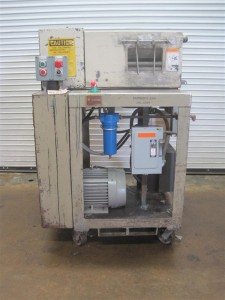Plastic pelletizing is the process of producing pellets from scrap plastic. An extruder melts and meters the plastic. It is passed through a die, cut, cooled and dried. The overall goal of pelletizing is to create a uniform pellet size to be re-introduced into another process. Pelletizing is a value added process and uniform pellets are more valuable on the market.
There are 4 basic types of pelletizers on the market today. Each style of machine has numerous design features and process advantages that we will discuss below.
Strand PelletizerAn extruder pumps plastic through a strand die that resembles spaghetti like strands. The  strands are then cooled in a water bath. The strands are typically dried with an air knife. An air knife is a blower with an air manifold that specifically directs air to blow excess water off. The now cooled and dry strands with enter the pelletizer. The pelletizer will pull the strands in with a set of pull rolls. The pull rolls are often speed controlled. The Pelletizer rotor rotates against the bed knifes to produce a pellet. The width of the pelletizer rotor is an important factor in determining output. The wider the rotor, the more strands will be able to feed at the same time thereby increasing output.
strands are then cooled in a water bath. The strands are typically dried with an air knife. An air knife is a blower with an air manifold that specifically directs air to blow excess water off. The now cooled and dry strands with enter the pelletizer. The pelletizer will pull the strands in with a set of pull rolls. The pull rolls are often speed controlled. The Pelletizer rotor rotates against the bed knifes to produce a pellet. The width of the pelletizer rotor is an important factor in determining output. The wider the rotor, the more strands will be able to feed at the same time thereby increasing output.
Pros
- Easy to clean
- Visual inspection of polymer
- Easy to set up/maintain
- Relatively inexpensive
- Technology advancements
- Variable speed pull rolls
- Self stranding waterslide or motorized conveyors Independently
- Driven pull rolls and rotor for size control
- Strand breakage
- Non uniformed pellet
- Large footprint
- Cutter head maintenance
The extruder pumps plastics through a die that is completely under water. The plastic passes through the die while a cutting head rotates several blades. The cut pellets are pumped up in a water slurry. The water pellet mixture is introduced to a centrifugal dryer. The centrifugal dryer spins away excess water and the now dry pellets are discharged.
Pros- Very consistent pellet
- Works well with most materials
- High level of automaton
- Technology advancements
- Micropellets
- Spring loaded cutters
- Polymer diverters
- Temperature must be controlled to avoid freeze ups.
- Typically higher cost
- Often requires higher level of training to operate
The pellet is cut hot through the die and then cooled through in a water ring. Pellets have a brief exposure to air, but then thrown into a water circulating ring for cooling. The pellets
 Beringer Water Ring Pelletizer
Beringer Water Ring Pelletizer
are never fully underwater in this process. After cut, the pellets the pellets slide into a centrifugal dryer to spin away excess water .
Pros- Relatively inexpensive
- No freeze ups
- Very easy To operate
- Technology advancements
- Retractable cutter head for quick change
- Difficult to run
- High melt material
- Pellet are not perfectly round
The Hot cut pelletizing process happens when plastic passes through and a rotating blade cuts the pellets inside a chamber. Air is used instead of water to cool and convey the newly cut pellets. Typically a pellet cooler is used for additional cooling type and can also be used for size classification. This is used typically with PVC. Cincinnati Milacron is the most widely used equipment for this type of process.
Pros
- Simple process
- No water required
- Very dusty
- Limited materials

